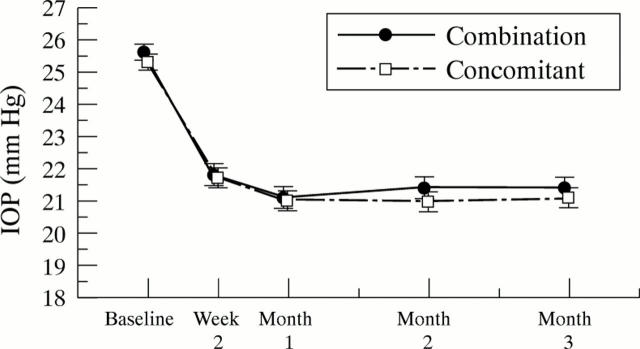Abstract
AIMS—To compare the tolerability and efficacy of a fixed combination solution of dorzolamide/timolol (Cosopt), administered twice daily with the concomitant administration of its components, dorzolamide (Trusopt) twice daily and timolol (Timoptic) twice daily. METHODS—After a 2 week timolol run in, patients with open angle glaucoma or ocular hypertension were randomised (1:1) to receive treatment with either the dorzolamide/timolol combination solution twice daily (combination) or the dorzolamide solution twice daily plus timolol maleate solution twice daily (concomitant) for 3 months. RESULTS—299 patients were entered and 290 patients completed the study. Compared with the timolol baseline, additional IOP lowering of 16% was observed at trough (hour 0) and 22% at peak (hour 2) at month 3 in both the concomitant and combination groups. The IOP lowering effects of the two treatment groups were clinically and statistically equivalent as demonstrated by the extremely small point differences (concomitant − combination) observed in this study−0.01 mm Hg at trough and 0.08 mm Hg at peak. The safety variables of the concomitant and combination groups were very similar. Both combination and concomitant therapy were well tolerated and few patients discontinued due to adverse effects. CONCLUSIONS—The dorzolamide/timolol combination solution administered twice daily is equivalent in efficacy and has a similar safety profile to the concomitant administration of the components administered twice daily. Keywords: dorzolamide; timolol; intraocular pressure; glaucoma; ocular hypertension
Full Text
The Full Text of this article is available as a PDF (121.7 KB).
Figure 1 .
IOP treatment means and standard errors at hour 0 (trough) by study visit; "all patients treated" analysis (last observation carried forward), worse eye.
Figure 2 .
IOP treatment means and standard errors at hour 2 (peak) by study visit; "all patients treated analysis" (last observation carried forward), worse eye.
Selected References
These references are in PubMed. This may not be the complete list of references from this article.
- Laibovitz R., Boyle J., Snyder E., Strohmaier K., Adamsons I. Dorzolamide versus pilocarpine as adjunctive therapies to timolol: a comparison of patient preference and impact on daily life. Clin Ther. 1996 Sep-Oct;18(5):821–832. doi: 10.1016/s0149-2918(96)80042-7. [DOI] [PubMed] [Google Scholar]
- Strahlman E. R., Vogel R., Tipping R., Clineschmidt C. M. The use of dorzolamide and pilocarpine as adjunctive therapy to timolol in patients with elevated intraocular pressure. The Dorzolamide Additivity Study Group. Ophthalmology. 1996 Aug;103(8):1283–1293. doi: 10.1016/s0161-6420(96)30509-5. [DOI] [PubMed] [Google Scholar]
- Strahlman E., Tipping R., Vogel R. A double-masked, randomized 1-year study comparing dorzolamide (Trusopt), timolol, and betaxolol. International Dorzolamide Study Group. Arch Ophthalmol. 1995 Aug;113(8):1009–1016. doi: 10.1001/archopht.1995.01100080061030. [DOI] [PubMed] [Google Scholar]




